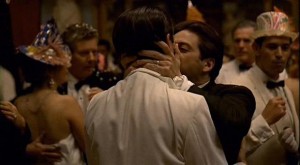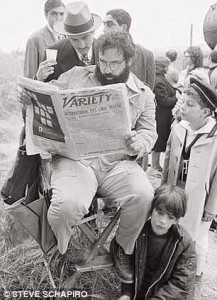Thanks to AMC, I’m reminded that The Godfather Part II turns 35 (edit: 41) this year. (And they should know, they show it on a bi-weekly loop.)
I’m not especially interested in adding to overwhelming opinion that decrees The Godfather series cinema’s greatest achievement. For one, is it? More importantly, who cares? The movies are indisputably great, and that should suffice. Besides, that type of coronation is usually the sole province of dorks who actually make it a point to rank artistic achievement. Like, for instance, declaring that Chinatown is the only perfect American film ever made. Regardless, while each one has its issues, taken together, The Godfather saga is tough to top. That’s good enough for me.
One more thing. The Godfather Part Two may not be perfect, but it does have what is quite possibly the best scene in movie history. The final scene is a sort of alpha and omega for film, maybe even Art. How does it do this? Simple, it’s perfect. It not only manages to connect all the threads of almost six hours (and two generations) of Mafia melodrama, it is also elegaic in almost operatic fashion: instead of being an overture, it is a coda. It doesn’t project the future (if so, it might have foreseen that the ill-begotten Godfather Part Three should have been aborted, like Kay and Michael’s third child), it retreats into the past, something Michael will be spending a great deal of time doing from here on out. It’s a complete triumph of writing, acting and direction. What’s remarkable is how Francis Ford Coppola made the most with what he had (or more importantly, how–as often seems to be the case with incredible art–circumstances conspired to impel brilliance). To wit, the famously impossible Marlon Brando petulantly refused to appear for one day of filming, so Coppola had to rework the scene without him. Ironically, it is considerably better for his absence. That is not a slight on The Don; his presence pervades the scene: he is spoken about, he is at the height of his powers at this moment and his influence over each character and all of the events is palpable (indeed, in one wonderful moment, the dimwitted Fredo–poor Fredo–cuts the Japanese some slack for Pearl Harbor by noting “they didn’t know it was Pop’s birthday”). Vito looms large enough, any interaction with his sons would have sucked up the air in the room and left little space for the import of what unfolds. In the entire arc of the story writ small, each character succinctly expresses their unique M.O., or hints at strengths or flaws we have already seen (Sonny’s temper, Fredo’s aforementioned simplicity, Michael’s considerable–and underestimated–resolve, Tom’s quiet sagacity) as well as the tragic twists we know will unravel (Carlo and Connie, Tessio).
The scene could only come at the end, but it encapsulates everything that happened (even before the primary action of the first film) and it colors how we know the rest of Michael’s life will be: alone, full of resentment, regrets and memories. In less than five minutes, it is at once amusing and moving, it summarizes and portends. It is one of the extraordinarily rare artistic achievements that might be called, without hyperbole, miraculous.


